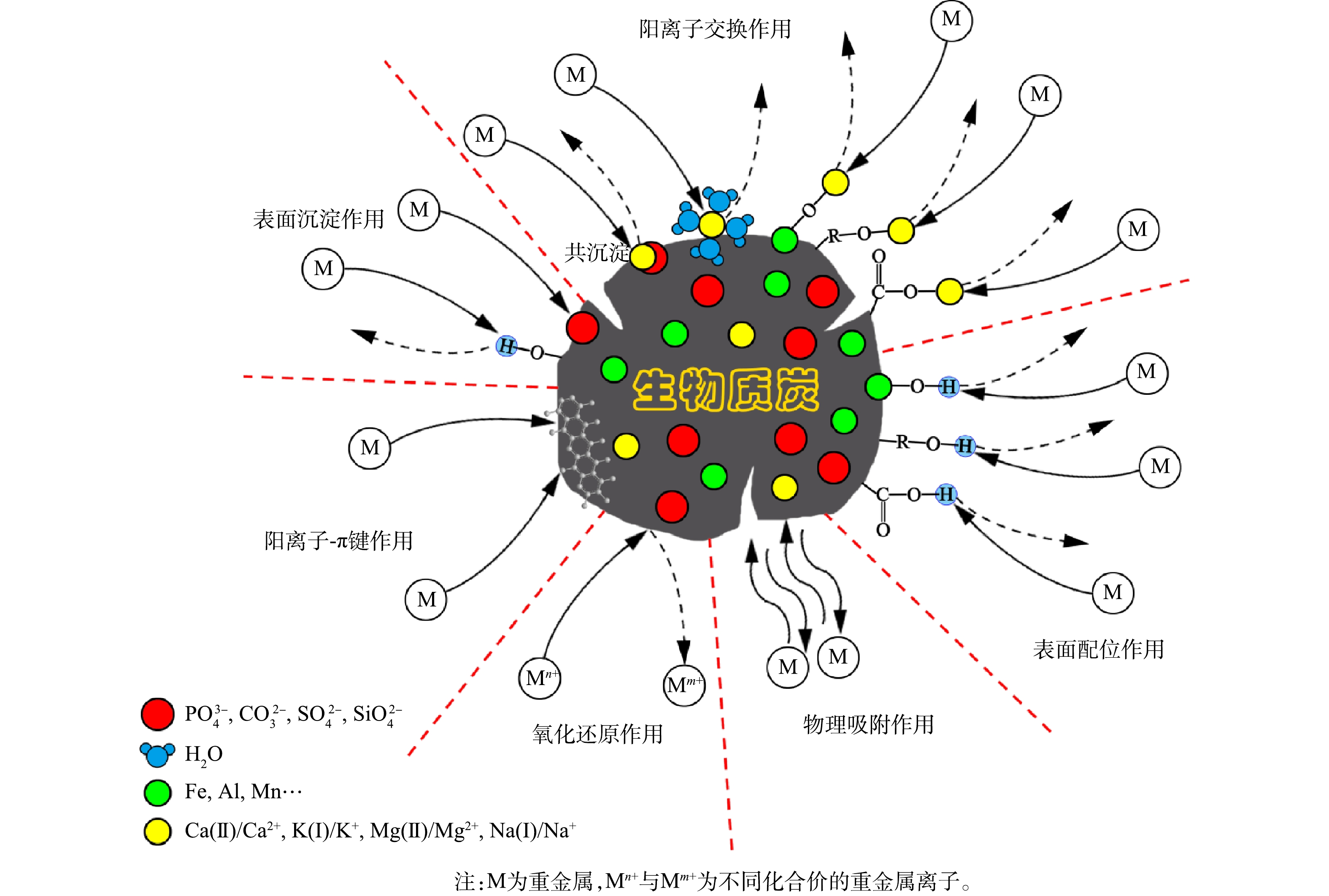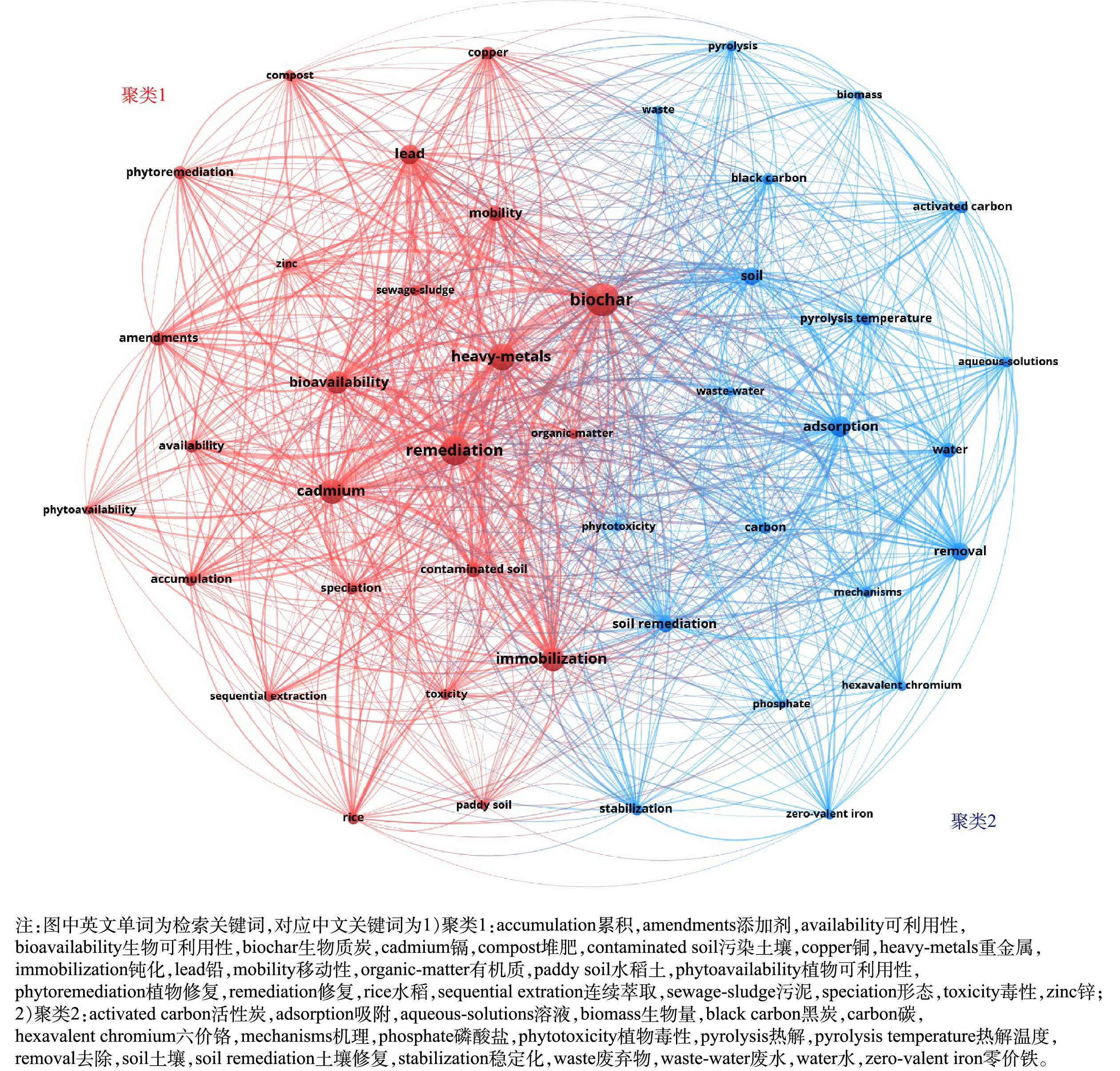-
土壤是人类赖以生存和发展的重要基础资源和环境。重金属为土壤中的主要污染物,其超标点位占土壤总污染超标点位的82.8%[1]。其中,八大主要污染重金属及其点位超标率分别为镉(7.0%)、汞(1.6%)、砷(2.7%)、铜(2.1%)、铅(1.5%)、铬(1.1%)、锌(0.9%)和镍(4.8%)。重金属具有隐蔽性、长期性、不可降解性和生物累积性,并可随食物链进行传播[1],一旦进入土壤将导致土地退化、食品安全等问题[2]。因此,解决土壤重金属污染问题刻不容缓。
原位钝化是重要的重金属污染土壤原位修复技术。通过将钝化剂加入土壤,改变重金属的赋存形态,降低其在土壤中的移动性和生物利用性,从而降低土壤中重金属的生物毒性。该技术具有操作简单、运行成本低和绿色环保等优点,是一种经济高效且非破坏性的土壤修复处理方式[1]。由于废弃生物质材料具有来源广泛、储量丰富及成本低廉等优点,近年来生物质炭土壤重金属钝化剂的研究受到广大学者的极大关注[3]。
生物质炭化技术作为一种快速、高效的热处理方式,制得的生物质炭具有含碳量高、稳定性好、比表面积大及吸附性能好等优点,被广泛应用于生态环境保护、能源开发利用和农业生产等领域[4]。在生态环境保护方面,生物质炭作为吸附剂可以有效吸附有毒有害气体、重金属及有机污染物[5-7];此外,生物质炭还可以作为碳汇,有效封存土壤碳,缓解全球变暖[8];在能源开发利用方面,生物质炭可以作为煤的替代能源用于发电、发热[9];在农业生产方面,生物质炭以生物有机肥形式施加进入土壤,可以有效提升土壤肥力,提高农作物产量[10]。目前,在生物质炭修复重金属污染土壤领域,呈现出以热解型生物质炭为主,其他生物质炭材料并存的发展态势。
鉴于当前缺少对生物质炭修复重金属污染土壤的系统总结及对修复机理的深入研究,本文以近年来生物质炭在土壤重金属修复领域所取得的研究成果为基础,从生物质炭的基本概况、重金属污染土壤的修复机理、修复影响因素及当前研究热点等方面进行梳理,并就未来重点研究方向进行了展望,以期为生物质炭及土壤重金属修复领域研究人员提供参考。
全文HTML
-
生物质炭是通过生物质炭化技术制备而成的富碳材料,其制备技术主要包括慢速热解炭化及水热炭化(湿式热解)。慢速热解主要是指在较低的升温速率下,在一个比较宽的温度范围内停留较长时间的热处理方式,生物质炭化产率较高。水热炭化主要是将生物质原料置于密闭反应容器中,以水为介质,在180~260℃和系统自生压力下,通过一系列复杂化学反应(水解、脱水、脱羧、缩聚和芳香化等)炭化的技术[11]。根据其制备方式,生物质炭可分为热解生物质炭和水热生物质炭即热解炭和水热炭[12]。
-
pH值是生物质炭的重要理化指标。根据pH值的不同,生物质炭在生态环境保护领域的应用也不同。通过不同的炭化方式,可制得具有不同pH值的生物质炭。热解炭化的炭化温度普遍较高,在此温度条件下,生物质表面的大量酸性含氧官能团(羧基、酚羟基等)会因剧烈的脱水、脱羧等反应而被去除。因此,热解炭的极化程度较低,表面含氧官能团较少。此外,生物质本身所含有的钾、钙、钠、镁等营养元素在热解过程中可转化为各矿质元素的氧化物、碳酸盐和磷酸盐并以灰分的形式保留,这些组分往往呈碱性。因此,在高温条件下制得的热解炭一般呈碱性;但当低温热解炭化时,因含有表面酸性含氧官能团,热解炭也会呈现为酸性。
相比而言,水热炭往往呈现出相对较强的酸性。这主要是因为水热炭化的温度较为温和(180~260 ℃)[13],表面富含以羧基和酚羟基为主的表面酸性含氧官能团。一般而言,水热炭化温度越高,水热炭的酸性越强。这主要是由于水热温度的升高促进了包括甲酸和乙酸等小分子有机酸的生成,大大降低了水热液相的pH值[11],而液相环境酸性的增强会抑制羧基脱羧,导致水热炭的酸性更强。
-
生物质炭主要由碳、氢、氧、氮、硫、硅等元素组成。不同生物质来源的生物质炭元素组成有所差别,但通常碳为生物质炭中含量最高的元素,其次为氧和氢。对于氮、硫和磷元素,蛋白质来源的生物质炭(藻类和甲壳素等)含量较高;木质纤维素来源的生物质炭的含量均较低。钾、钙、钠、镁、硅等无机元素主要存在于灰分中,并且草本植物来源的生物质炭的灰分往往大于木本植物。相较于热解炭化技术,水热炭化过程中,易溶于水的无机元素比如钾、钠等元素会进入液相。因此,水热炭的灰分远远低于热解炭。
生物质炭的表面物化特性与炭化处理方式和炭化温度有着密切关系。生物质炭化将生物质中的不稳定有机组分分解并转化为不可凝结气体、生物油和生物质炭[14],分解产物释放时可产生相应大小的空洞,使得生物质炭相比于原生生物质的孔隙率和比表面积都大大提升[15]。热解炭化温度往往高于水热炭化温度,因此,热解炭的孔隙结构较水热炭更为丰富,比表面积更大。同时,由于炭化温度较高,生物质表面的含氧官能团会因强烈的脱水和脱羧反应而去除,导致热解炭的表面含氧官能团远远低于水热炭。
水热炭化技术炭化温度较为温和、范围较窄,提高炭化温度有助于去除挥发分,改善水热炭的孔隙结构,从而可在一定程度上提升水热炭的比表面积。但对于热解炭化技术,在一定温度范围内(200~750℃)提高炭化温度可以提高热解炭比表面积,但温度过高(800℃)会导致孔隙坍塌,从而导致热解炭比表面积下降[16]。此外,随炭化温度的升高,生物质炭表面含氧官能团会逐渐减少。
1.1. 生物质炭的制备方式及分类
1.2. 生物质炭的pH值
1.3. 生物质炭的元素组成及表面物化特性
-
生物质炭的表面基团可以与重金属结合形成难溶物质。呈碱性的生物质炭添加进入土壤之后可以提高土壤的pH值,从而促进土壤中重金属与表面基团结合形成难溶的金属氢氧化物、金属碳酸盐及磷酸盐等难溶物,降低重金属的可迁移性及生物毒性。重金属的含量与生物质炭的pH值会显著影响难溶物的存在形式,从而影响重金属钝化效率。例如,铅与生物质炭结合时多以Pb9(PO4)6及Pb3(CO3)OH2的形式存在;当铅含量较低时,铅在生物质炭表面主要以Pb5(PO4)3(OH)的形式存在;当pH值较低时,铅在生物质炭表面沉淀主要以PbCO3的形式存在。不同的重金属表面沉淀形式也不同。对于镉,在生物质炭表面沉淀则主要以Cd3(PO4)2、CdCO3、K4CdCl6、Cd3P2和Cd(OH)2形式存在[17]。此外,在重金属发生表面沉淀的过程中还会发生共沉淀现象,形成的重金属沉淀可以包覆游离的重金属离子,并将其固定在沉淀内部,从而降低其迁移性[18]。
-
生物质炭尤其水热炭表面含有丰富的含氧官能团(比如羧基和羟基),这些官能团可以与土壤中重金属进行配位结合,形成稳定的配合物或螯合物,从而降低重金属的迁移性及其生物毒害作用[19-20]。不同重金属其离子半径不同,与不同配体的结合能力和结合形式也不同,因此,通过表面配位作用与生物质炭结合的能力亦有所区别。现有研究表明,与有机质炭结合的重金属强弱依次为铜>铅>镉。这主要是由于有机质与铜的结合是通过双五元环的羧酸配体络合的形式,比单齿配体配位结合的铅、镉更加稳定[21]。此外,由软硬酸碱理论,铅为硬酸,镉为软酸,铅比镉更容易与生物质炭表面的硬碱羟基结合。因此,有机质炭与铅的结合能力大于镉[22]。
-
在生物质炭对重金属的吸附能力弱的时候,离子交换是重金属钝化的主要机制。生物质炭的表面具有很多官能团,这些官能团大多数带负电荷,可通过范德华力、氢键及静电吸附等物理作用力在生物质炭表面吸附大量的钾、钙、钠、镁等离子。这些碱金属或碱土金属离子可以和土壤中的重金属阳离子发生置换,从而将其捕获并固定在生物质炭上[23]。离子交换作用的缺点是可逆性强,并且对于外界pH的变化极其敏感。
-
氧化还原作用主要针对铬、砷等具有变价的重金属。这类重金属以不同价态的化学形式存在时往往表现出对环境的不同毒害作用,氧化还原修复的机理就是通过改变变价重金属的化学价态来降低其对环境的毒害作用。例如,生物质炭表面具有醌基-氢醌的氧化还原电子对和酚基共轭π电子系统,可以同时作为电子给体和电子受体,提供大量的氧化还原点位[24],改变变价金属的化合价;又如,热解炭和水热炭可介导还原无机金属离子(比如Cr(Ⅵ)和Fe(Ⅲ))。对于铬,Cr(Ⅲ)和Cr(Ⅵ)为稳定存在形态,而Cr(Ⅵ)的毒性和氧化能力比Cr(Ⅲ)更强。通常Cr(Ⅵ)会通过氧化还原机制转变为毒性较低的Cr(Ⅲ),此后Cr(Ⅲ)经表面沉淀、表面配位、离子交换等机制被生物质炭固定,从而进一步降低其对环境的毒害作用[25]。而砷的常见化合价态为As(Ⅲ)和As(Ⅴ),As(Ⅲ)常以无机物形态As2O3存在,毒性极强;相比于As(Ⅲ),As(Ⅴ)毒性较低,且常以砷酸盐等阴离子形式存在。碱性的生物质炭加入土壤之后,会产生静电排斥作用,这会增加砷的移动性。而砷的生物积累是生物质炭特别是热解炭在土壤修复工作中的常见问题[26]。相对而言,水热炭表面具有丰富的酸性含氧官能团,其氧化电位远远高于热解炭,可有效降低砷的移动性和生物毒性。
-
阳离子-π键作用是一种极强的非键作用力,其键结强度超过氢键,相当于形成内轨和外轨配合物的配位键[27]。这种非键作用力广泛存在于阳离子与π电子体系之间,包括芳香环共轭π电子体系以及乙烯、乙炔等简单的π电子体系,故被称为阳离子-π键作用[28]。阳离子-π键作用是生物质炭吸附重金属的重要机理之一。生物质炭大的表面能使其对重金属具有极大的亲和力。这主要是由于生物质炭(尤以热解炭为主)具有相对集中的芳香化结构,而重金属阳离子通常具有空的d轨道,可以为π电子提供轨道,两者可以形成紧密的共价电子云结构。此外,生物质炭的芳香化程度越高,对重金属的结合受外界pH的影响更小,对重金属的结合能力也越强。
-
与化学作用力相比,物理吸附作用力是广泛存在的一种弱相互作用力,主要包括氢键、静电吸引、范德华力。物理吸附作用对重金属的吸附不具有选择性并且具有强可逆性,通常作为原位钝化的前导作用力,将游离的重金属离子吸引到生物质炭及土壤胶体颗粒表面,便于后续的强化学作用力对重金属进行固定,从而减少其环境毒性。生物质炭修复重金属污染土壤的机理如图1所示。
2.1. 表面沉淀作用
2.2. 表面配位作用
2.3. 离子交换作用
2.4. 氧化还原作用
2.5. 阳离子-π键作用
2.6. 物理吸附作用
-
pH值是影响土壤重金属修复效果的重要因素,会直接影响生物质炭的表面电荷分布和表面含氧官能团的存在形态[20]。当外界pH值较低时,环境中H+浓度过高,H+会与土壤中重金属离子在生物质炭表面发生竞争吸附,从而大大降低生物质炭对重金属的钝化效率。此外,在低pH值条件时,生物质炭表面含氧官能团被质子化,其会与土壤中重金属离子发生静电排斥,不利于重金属离子向生物质炭表面的迁移,从而进一步抑制了重金属的表面配位。当pH值逐渐上升,H+抑制作用会逐渐减小;当外界pH值达到中性并进一步上升,官能团质子化消失,生物质炭对重金属配位能力增强,钝化效率增加;当外界pH值继续上升,环境中OH−浓度超过H+浓度时,表面含氧官能团出现脱质子现象,生物质炭表现出对重金属的强配位能力[29];当OH−浓度达到一定水平时,土壤溶液中游离的重金属离子会与OH−结合得到难溶的氧化物或氢氧化物沉淀,进而大大降低重金属的迁移性和生态毒性。
-
孔隙结构是生物质炭重要的物理性质,对于重金属钝化发挥着重要作用。有研究发现,生物质炭丰富的孔隙结构可以增加土壤的孔隙度,从而提高土壤对重金属的吸附能力。此外,生物质炭的孔隙结构越发达,则比表面积越大,所提供的用于重金属吸附的活性点位就越多[30]。
-
生物质炭表面的含氧官能团的含量直接决定了生物质炭与重金属之间的主要作用机制。热解炭表面含氧官能团较少,对于土壤中重金属的作用机制主要源于表面沉淀、离子交换等作用[31]。水热炭的孔隙结构不发达、灰分含量少,但其表面具有丰富的含氧官能团,故水热炭与土壤中重金属的作用机制主要源于表面配位作用,而其表面沉淀、离子交换等作用相对较弱[20]。此外,生物质炭的极化程度与表面含氧官能团和脂肪性烷基基团含量具有密切相关性。一般来说,若水热炭的芳香化程度低,则极化程度高。因此,对重金属具有更强的吸附作用力和配位能力[20]。
-
生物质炭来源和炭化反应温度等条件会对生物质炭的土壤重金属钝化效率产生间接影响。不同生物质来源的生物质炭其元素组成、表面孔隙结构和表面含氧官能团亦不同。另外,在一定范围内升高炭化温度有利于增加生物质炭的比表面积,丰富其孔隙结构;但同时表面含氧官能团含量也会因炭化温度的升高而减少,从而导致生物质炭对重金属的配位结合能力降低。因此,选择适宜的生物质原料和适宜的炭化技术及炭化条件对于制备生物质炭土壤重金属钝化剂尤为重要。
3.1. pH值对修复效果的影响
3.2. 表面孔隙结构的影响
3.3. 表面含氧官能团的影响
3.4. 其他间接影响因素
-
为深入了解生物质炭修复重金属污染土壤的研究热点及发展趋势,采用文献可视化软件VOSviewer,基于Web of Science(WOS)数据库对其进行数据挖掘和定量分析。在WOS核心合集中限制检索语种为English,文献类型为Article,并按照检索式TS=((hydrochar or biochar) and (“heavy metal” or cadmium or lead or copper or zinc or chromium or nickel or arsenic or mercury) and soil and remediation)进行检索,检索时间截止2020年11月30日,共检索到相关文献735篇。将检索数据以全纪录形式导出并作为文献计量分析的原始分析数据,运用VOSviewer对其进行关键词共现分析。
图2为生物质炭修复重金属污染土壤的关键词共现网络图,关键词被划分为2大聚类。聚类1与生物质炭土壤重金属修复及修复效果密切相关,其中出现频次前10的关键词有生物炭、修复、重金属、镉、钝化、生物可利用性、铅、移动性、改良剂和污染土壤,说明生物质炭修复重金属污染土壤的主要研究对象为热解炭,而水热炭的研究较少。另外,生物质炭对于重金属污染土壤的修复主要采用原位钝化的处理方式,通过改变重金属的化学存在形态降低其移动性和生物可利用性,从而降低其环境毒害作用。在8大重金属污染物(镉、汞、砷、铜、铅、铬、锌、镍)中,镉、铅、铜、锌为出现在聚类1的高频词,表明生物质炭对重金属的钝化主要研究对象为镉和铅,其次为铜锌。聚类2与生物质炭土壤重金属修复机理、生物质炭优化改性和植物响应密切相关,与其相关的关键词有吸附、去除、热解温度、稳定化、活性炭、机理、六价铬、零价铁、生物量和植物毒性等。生物质炭对于阴离子型的重金属的钝化效果有限,通过负载零价铁和氧化铁可以调控生物质炭的性能,从而改变对于六价铬和三价砷的去除效果。此外,在评估生物质炭修复重金属污染土壤的效果时,通常也会考量其对于植物生长的影响,比如对植株长度和植株生物量以及植物对于重金属的生物积累。生物质炭的钝化机理作为其在土壤重金属修复领域重要的一环,往往会涉及液相金属离子的吸附能力。然而,除极少数研究可借助磁性生物质炭的磁性以及生物质炭粒度控制对生物质炭进行分离之外[32-33],尚存在难以将生物质炭从修复土壤中分离从而难以进行循环使用或者机理分析的问题。因此,现有研究一般借助于液相吸附实验进行。
-
废弃生物质具有价格低廉、来源广泛等特点,将其材料化进行循环利用是优先选择的处理方式。生物质炭主要涵盖以废弃生物质为原料通过热解法制得的热解炭和水热法制得的水热炭。生物质炭在修复重金属污染土壤方面具有巨大的潜力,将其施加进土壤不仅可以有效降低土壤中重金属的毒性,还可以提升土壤的肥力,促进植物的生长。
目前,生物质炭在修复重金属污染土壤方面主要存在以下问题:1)实际土壤污染往往是多种重金属的混合污染,生物质炭在钝化某些重金属的同时尚存在增加其他金属的迁移和环境毒害的潜在风险;2)实际修复的土壤环境涉及机理非常复杂,生物质炭物化性质、微生物、气候、人为活动等自然或非自然的影响导致生物质炭实际修复效果往往有限;3)原位钝化对于环境pH值的变化、微生物活动等因素较为敏感,钝化的重金属特定条件下会从重新释放,需要长期的环境监测;4)当前生物质炭在修复重金属污染土壤方面主要以短期研究为主,缺乏长期的田间试验数据。因此,研发性能优越的生物质炭基复合材料弥补生物质炭专项性不足的缺陷,以及开发廉价的表面改性方式,增强生物质炭对目标重金属的结合能力均尤为重要。另外,原位钝化法只能降低重金属对环境的危害而无法将其根除,应考虑多种修复技术联用的方式如将其与植物修复相结合的方式,在保证快速降低土壤中重金属危害的同时可以逐渐将重金属从土壤中去除来彻底消除其对于环境的潜在风险。




 下载:
下载:



